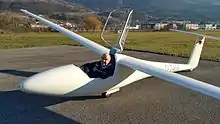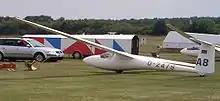Glasflügel 205 Club Libelle
The Glasflügel 205 Club Libelle is a high wing, T-tailed, single seat glider that was designed and produced in West Germany by Glasflügel for club and rental use.[1][2]
| 205 Club Libelle | |
|---|---|
 | |
| Role | Glider |
| National origin | West Germany |
| Introduction | 1975 |
| Status | Production completed |
| Number built | 171 (as of 1983) |
| Developed from | Glasflügel H-201 |
Design and development



| External image | |
|---|---|
The Glasflügel H-201 Standard Libelle proved immensely popular, but was not an optimal aircraft for club and rental use, due to its mid-wing and low tail which could both be damaged in off-airport landings. Also its small cockpit fits only a certain demographic percentage of soaring pilots. The company developed the 205 with the design goals of a simple, rugged aircraft that would withstand club and fixed-base operator rental use. The resulting aircraft has a high-wing and a T-tail to provide more obstacle clearance as well as a larger cockpit. To eliminate gear-up landings the monowheel landing gear is non-retractable,[1][2] although at least one Club Libelle exists (D-2468) which is equipped with retractable landing gear.
The aircraft is constructed from fibreglass. It has a new wing that uses a double-taper planform and incorporates combination spoilers and flaps that occupy two thirds of the wing's trailing edge. The 15.0 m (49.2 ft) span wing employs a Wortmann FX 66-17A II 182 airfoil, the same as is used on the Standard Libelle and the Glasflügel 206 Hornet.[1][2][3]
The Club Libelle was type certified in Germany as well as in the United States. The US certification was granted on 8 September 1975 and includes aerobatic approval for spins, loops, hammerhead turns and lazy eights. Due to its fibreglass construction, the aircraft's certification contains the restriction: "All external portions of the glider exposed to sunlight must be painted white. Registration and competition numbers must be painted blue-gray or in any other light color."[4]
Operational history
In July 2011 there were six 205s on the United States Federal Aviation Administration registry.[5]
Specifications (205)
Data from Sailplane Directory, Soaring and US Type Certificate G12eu[1][2][4]
General characteristics
- Crew: one
- Wingspan: 15.0 m (49 ft 3 in)
- Wing area: 9.80 m2 (105.5 sq ft)
- Aspect ratio: 23:1
- Airfoil: Wortmann FX 66-17A II 182
- Empty weight: 200 kg (440 lb)
- Gross weight: 350 kg (772 lb)
Performance
- Stall speed: 70 km/h (44 mph, 38 kn) with dive brakes closed
- Never exceed speed: 200 km/h (124 mph, 108 kn)
- Maximum glide ratio: 35:1 at 56 mph (90 km/h)
- Rate of sink: 0.56 m/s (110 ft/min) at 42 mph (68 km/h)
- Wing loading: 34 kg/m2 (6.9 lb/sq ft)
See also
Aircraft of comparable role, configuration, and era
Related lists
References
- Activate Media (2006). "Club Libelle 205 Glasflugel". Archived from the original on 25 August 2012. Retrieved 10 July 2011.
- Said, Bob: 1983 Sailplane Directory, Soaring Magazine, page 80, Soaring Society of America November 1983. USPS 499-920
- Lednicer, David (2010). "The Incomplete Guide to Airfoil Usage". Archived from the original on 20 April 2010. Retrieved 1 July 2011.
- Federal Aviation Administration (September 1975). "Type Certificate Data Sheet SHEET NO.G12EU" (PDF). Retrieved 10 July 2011.
- Federal Aviation Administration (July 2011). "Make / Model Inquiry Glasflugal 205". Retrieved 10 July 2011.
External links
| Wikimedia Commons has media related to H205 Club Libelle. |